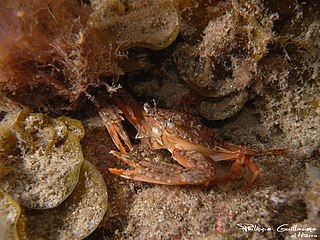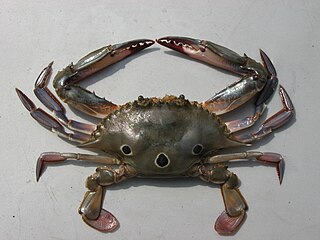
Portunus is a genus of crabs which includes several important species for fisheries, such as the blue swimming crab and the Gazami crab. Other species, such as the three-spotted crab are caught as bycatch.

Soft-shell crab is a culinary term for crabs that have recently molted their old exoskeleton and are still soft. Soft-shells are removed from the water as soon as they molt or, preferably, just before to prevent any hardening of their shell. Catching soft-shell crab is very time-sensitive and requires that any caught crabs be kept in climate-controlled areas immediately after catching until they molt, at which point they can be safely removed and sold.
The common term sand crab can refer to various species of crustacean:

A crab cake is a variety of fishcake popular in the United States. It is composed of crab meat and various other ingredients, such as bread crumbs, mayonnaise, mustard, eggs, and seasonings. It is then sautéed, baked, grilled, deep fried, or broiled. Crab cakes are traditionally associated with the Chesapeake Bay, in the state of Maryland. Although the earliest use of the term "crab cake" is commonly believed to date to Crosby Gaige's 1939 publication New York World's Fair Cook Book in which they are described as "Baltimore crab cakes," earlier usages can be found such as in Thomas J. Murrey's book Cookery with a Chafing Dish published in 1891.

Portunus pelagicus, also known as the flower crab, blue crab, blue swimmer crab, blue manna crab or sand crab is a species of large crab found in the Indo-Pacific, including off the coasts of Indonesia, Malaysia, Cambodia, Thailand, the Philippines, and Vietnam; and in the intertidal estuaries around most of Australia and east to New Caledonia.

Portunidae is a family of crabs which contains the swimming crabs. Its members include many well-known shoreline crabs, such as the blue crab and velvet crab. Two genera in the family are contrastingly named Scylla and Charybdis; the former contains the economically important species black crab and Scylla paramamosain.

Portunus trituberculatus, also known as the gazami crab, Asian blue crab or horse crab, is the most widely fished species of crab in the world. It is found off the coasts of East Asia and is closely related to Portunus armatus.
The common name blue land crab can be applied to either of two terrestrial crab species:

USS Portunus (ARC-1) was an LSM-1-class landing ship medium acquired by the U.S. Navy for use during World War II as a landing craft for troops, and later, as a cable repair ship.

Crab fisheries are fisheries which capture or farm crabs. True crabs make up 20% of all crustaceans caught and farmed worldwide, with about 1.4 million tonnes being consumed annually. The horse crab, Portunus trituberculatus, accounts for one quarter of that total. Other important species include flower crabs, snow crabs (Chionoecetes), blue crabs, edible or brown crabs, Dungeness crab, and mud crabs, each of which provides more than 20,000 tonnes annually.

Callinectes similis, sometimes called the lesser blue crab or dwarf crab, is a West Atlantic species of blue crab. It was described by Austin B. Williams in 1966.
Hematodinium is a genus of dinoflagellates. Species in this genus, such as Hematodinium perezi, the type species, are internal parasites of the hemolymph of crustaceans such as the Atlantic blue crab and Norway lobster. Species in the genus are economically damaging to commercial crab fisheries, including causing bitter crab disease in the large Tanner or snow crab fisheries of the Bering Sea.

Portunus sayi, the sargassum swimming crab, is a species of pelagic crab in the family Portunidae. It is found in the western Atlantic Ocean and the Caribbean Sea where it makes its home among floating mats of Sargassum seaweed. It was named in honour of the American naturalist Thomas Say.

Portunus sanguinolentus, the three-spot swimming crab, blood-spotted swimming crab or red-spotted swimming crab, is a large crab found throughout estuaries of the Indian and West Pacific Oceanic countries.
Daesh is the Arabic acronym for the Islamic State of Iraq and the Levant, a Salafi jihadist terrorist and militant group.

Portunus segnis, the African blue swimming crab, is a species of crustacean, a swimming crab belonging to the family Portunidae. While native to the western Indian Ocean, it is also invasive in the Mediterranean. It is thought to have come through the Suez Canal from the Red Sea but it may have been transported by ships.
Portunus armatus is a species of crustacean, a swimming crab in the family Portunidae found in Australia and eastwards to New Caledonia. Common names include blue swimmer crabs, Blue manna, Blueys, and Jennies. The species was originally considered as a geographic variation of Portunus pelagicus, however in 2010 the Portunus pelagicus species was reviewed using DNA, as well as physical characteristics including measurements and four species recognised: Portunus pelagicus, Portunus armatus, Portunus reticulatis and Portunus segnis. The range of Portunus armatus overlaps with Portunus pelagicus in the Northern Territory of Australia.











